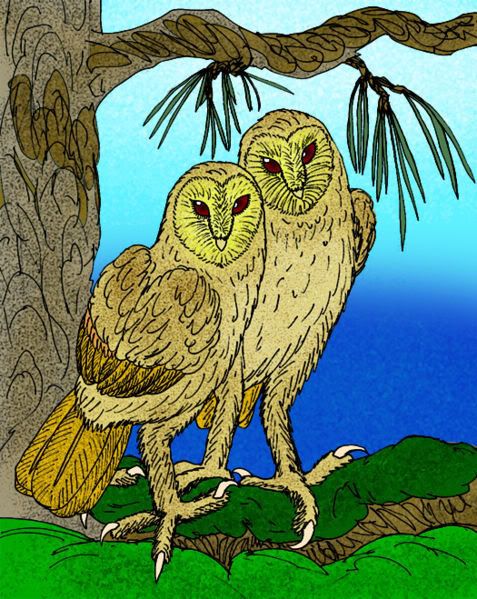|
|
Post by Melanie on Jun 4, 2005 15:05:35 GMT
2 foot tall flightless owl from Andros, Bahamas. A remote cousin of the smaller Common Barn-owl ( Tyto alba ). Tyto pollens was a large, flightless owl known to have lived on Andros. It is believed that it was territorially aggressive and coexisted with humans. The ability of owls to swivel their heads, and a territorial aggression, may have been the basis for the chickcharnie legend.
|
|
|
|
Post by Melanie on Jun 4, 2005 17:31:21 GMT
On Andros Island, Bahamas, an historically extinct species of flightless owl, Tyto pollens, scientifically known only from subfossils, stood one meter tall and may have been the source of old local legends of "chickcharnies" or aggressive leprachaun-like imps that wreak havoc, have three toes, and can turn their heads all the way around (Marcot 1995). This owl likely inhabited the dense stands of old-growth Caribbean pine (Pinus caribbeanensis), so much of which had been clearcut on Andros during the latter 20th century by American companies.
|
|
|
|
Post by another specialist on Jan 17, 2008 11:25:49 GMT
 Tyto pollens, also known as Andros Island Barn Owl, Bahaman Barn Owl, Bahaman Great Owl, or "Chickcharnie," was a 1 metre tall barn owl that lived in the old-growth pine forests of Andros Island. It made its nests in burrows. When the island of Andros was colonized by Europeans and their slaves in the 16th century, the owls coexisted with humans, at least until the forests were felled. The destruction of the original forests was the main cause of T. pollens' extinction. [edit] "Chickcharnie" Scholars believe that T. pollens inspired the legend of the "Chickcharnie," a malicious, bird-like dwarf with glowing red eyes, three-toed feet, and a head that could rotate in any direction that was said to haunt the forests of Andros by early settlers. en.wikipedia.org/wiki/Bahaman_Barn-owl |
|
|
|
Post by another specialist on May 15, 2008 14:20:27 GMT
|
|
|
|
Post by another specialist on May 16, 2008 8:18:07 GMT
|
|
|
|
Post by another specialist on Dec 8, 2008 12:56:14 GMT
|
|
|
|
Post by Melanie on Sept 23, 2015 12:04:38 GMT
After reviewing the systematics and distribution of the extinct West Indian taxa of Tytonidae (Tyto) larger than the living barn owl Tyto alba (Scopoli), we reached the following conclusions: (1) the species T. ostologa Wetmore (1922) is the only giant barn owl known so far from Hispaniola; (2) T. pollens Wetmore (1937) was a somewhat larger and even more robust representative of T. ostologa known from the Great Bahama Bank and Cuba; (3) the very rare species T. riveroi Arredondo (1972b) is here synonymized with T. pollens; (4) the smallest taxon of these giant barn owls is T. noeli Arredondo (1972a), which is widespread and abundant in Quaternary deposits of Cuba and is here reported for the first time from two cave deposits in Jamaica; (5) the only large barn owl named so far from the Lesser Antilles is T. neddi Steadman & Hilgartner (1999), which is here synonymized with T. noeli; (6) a new taxon from Cuba, T. cravesae new species, which in size approached the linear dimensions of T. ostologa, is named and described herein. Key words: Giant Tytonidae, distribution, fossil birds, systematics, Tyto, West Indies Zootaxa 4020 (3): 533–553 (23 Sept. 2015) Systematics and distribution of the giant fossil barn owls of the West Indies (Aves: Strigiformes: Tytonidae) WILLIAM SUÁREZ & STORRS L. OLSON www.mapress.com/zootaxa/2015/f/z04020p553f.pdf |
|
|
|
Post by Sebbe on Mar 21, 2018 23:36:51 GMT
|
|
|
|
Post by surroundx on May 2, 2019 14:09:01 GMT
|
|
|
|
Post by Sebbe on Mar 12, 2022 6:13:51 GMT
|
|